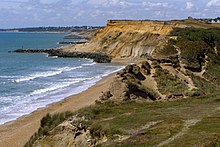| Site of Special Scientific Interest | |
 | |
| Location | Dorset Hampshire |
|---|---|
| Grid reference | SZ 239 926 |
| Interest | Geological |
| Area | 110.1 hectares (272 acres) |
| Notification | 1991 |
| Location map | Magic Map |
Highcliffe to Milford Cliffs is a 110.1-hectare (272-acre) geological Site of Special Scientific Interest which stretches along the south coast of England from Christchurch in Dorset to Milford on Seain Hampshire. It includes several Geological Conservation Review sites.
This site stretches along the cliffs of Christchurch Bay for 9-kilometre (5.6-mile). It exposes the fossil rich strata of the Barton Beds and Headon Beds, dating to the Eocene epoch around 40 million years ago, and is the type locality for many species of fauna and flora. The Barton Beds are capped by Pleistocene gravels which are rich in Paleolithic artefacts.
References
- ^ "Designated Sites View: Highcliffe to Milford Cliffs". Sites of Special Scientific Interest. Natural England. Retrieved 12 May 2020.
- "Map of Highcliffe to Milford Cliffs". Sites of Special Scientific Interest. Natural England. Retrieved 12 May 2020.
- "Hordle (Aves)". Geological Conservation Review. Joint Nature Conservation Committee. Retrieved 21 April 2020.
- "Hordle - Beacon Cliffs (Tertiary Palaeobotany)". Geological Conservation Review. Joint Nature Conservation Committee. Retrieved 21 April 2020.
- "Hordle Cliff (Tertiary Mammalia)". Geological Conservation Review. Joint Nature Conservation Committee. Retrieved 21 April 2020.
- "Hordle Cliff (Tertiary Reptilia)". Geological Conservation Review. Joint Nature Conservation Committee. Retrieved 21 April 2020.
- "Paddy's Gap (Tertiary Palaeobotany)". Geological Conservation Review. Joint Nature Conservation Committee. Retrieved 21 April 2020.
- "Highcliffe to Milford Cliffs citation" (PDF). Sites of Special Scientific Interest. Natural England. Retrieved 12 May 2020.
50°43′59″N 1°39′47″W / 50.733°N 1.663°W / 50.733; -1.663
Categories: